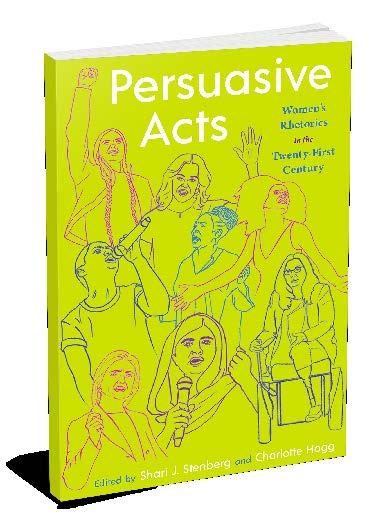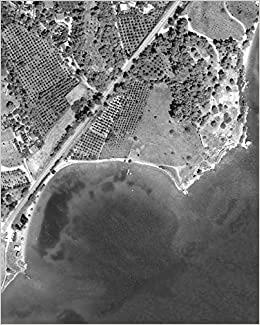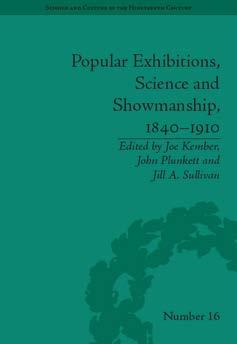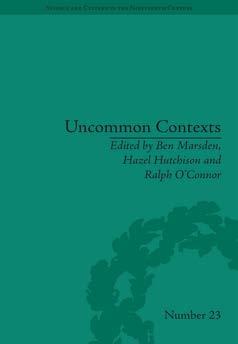
8 minute read
POLITICS, ECONOMICS & LAW
University of Pittsburgh Press 9780822966135 • Paperback 15 b&w • 229 x 152mm • 464 pages March 2020 • £25.00
About the editors:
Advertisement
Shari Stenberg is Professor of English and Women’s and Gender Studies at the University of Nebraska-Lincoln.
Charlotte Hogg is associate professor of English at Texas Christian University.
Related Titles:
Persuasive Acts
Women’s Rhetorics in the Twenty-First Century Edited by Shari J. Stenberg and Charlotte Hogg Series: Composition, Literacy, and Culture Women's and feminist rhetorics for the new millennium.
In June 2015, Bree Newsome scaled the flagpole in front of South Carolina’s state capitol and removed the Confederate flag. The following month, the Confederate flag was permanently removed from the state capitol. Newsome is a compelling example of a twenty-first-century woman rhetor, along with bloggers, writers, politicians, activists, artists, and everyday social media users, who give new meaning to Aristotle’s ubiquitous definition of rhetoric as the discovery of the “available means of persuasion.” Women’s persuasive acts from the first two decades of the twenty-first century include new technologies and repurposed old ones, engaged not only to persuade, but also to tell their stories, to sponsor change, and to challenge cultural forces that repress and oppress.
Persuasive Acts: Women’s Rhetorics in the TwentyFirst Century gathers an expansive array of voices and texts from well-known figures including Hillary Rodham Clinton, Malala Yousafzai, Michelle Obama, Lindy West, Sonia Sotomayor, and Chimamanda Ngozi Adichie, so that readers may converse with them, and build rhetorics of their own. Editors Shari J. Stenberg and Charlotte Hogg have complied timely and provocative rhetorics that represent critical issues and rhetorical affordances of the twenty-first century.
9781950690015 9781463207267
University of Gorgias Press Pittsburgh Press £95.00 £26.50
102
www.oxbowbooks.com trade@oxbowbooks.com
The Black Rhetorical Presence in White Culture
By Cedric D. Burrows Series: Composition, Literacy, and Culture How African American rhetoric becomes whitened when it crosses over into white audiences. In music, crossover means that a song has moved beyond its original genre and audience into the general social consciousness. Rhetorical Crossover uses the same concept to theorise how the black rhetorical presence has moved in mainstream spaces in an era where African Americans were becoming more visible in white culture. Cedric Burrows argues that when black rhetoric moves into the dominant culture, white audiences appear welcoming to African Americans as long as they present an acceptable form of blackness for white tastes.
University of Pittsburgh Press • 9780822946205 • Hardback 229 x 152mm • 168 pages • October 2020 • £38.00
Defiant Geographies
Race and Urban Space in 1920s Rio de Janeiro By Lorraine Leu Series: Illuminations

Examines an act of urban reform as a forgetting of the country’s racial past.
This book examines the destruction of a poor community in the centre of Rio de Janeiro to make way for Brazil’s first international mega-event. As the country celebrated the centenary of its independence, its post-abolition whitening ideology took on material form in the urban development project that staged Latin America’s first World’s Fair. The book explores official efforts to reorganise space that equated modernisation with racial progress.
University of Pittsburgh Press • 9780822946007 • Hardback 37 b/w illus. • 229 x 152mm • 224 pages • March 2020 • £32.00
Our Rightful Place
A History of Women at the University of Kentucky, 1880--1945 By Terry L. Birdwhistell and Deirdre A. Scaggs Series: Topics in Kentucky History The story of the first female students at the University of Kentucky.
Drawing on yearbooks, photographs, and other private collections, this book examines the struggle for gender equity in higher education through the lens of the University of Kentucky. In the face of shifting resistance, pioneering women constructed opportunities for themselves. By examining the trials and triumphs of the university’s first female undergraduates, faculty, and administrators, this book uncovers the lasting impact women had on higher learning in the early days of coeducation.
Science, Technology, and the Environment in Latin America's Long Cold War
Edited by Andra B. Chastain and Timothy W. Lorek Series: Intersections
Argues for the importance of expertise in the Latin American Cold War.
Itineraries of Expertise contends that experts and expertise played fundamental roles in the Latin American Cold War. While traditional Cold War histories of the region have examined diplomatic, intelligence, and military operations and more recent studies have probed the cultural dimensions of the conflict, the experts who constitute the focus of this volume transcend these categories.
University of Pittsburgh Press • 9780822945963 • Paperback 22 b/w illus. • 229 x 152mm • 480 pages • March 2020 • £30.00
Radiation Evangelists
Technology, Therapy, and Uncertainty at the Turn of the Century By , Jeffrey Womack A cautionary tale of technological medical progress and the consequences of human experimentation.
Explores x-ray and radium therapy in the United States and Great Britain during a crucial period of its development, from 1896 to 1925. It focuses on the pioneering work of early advocates in the field, the “radiation evangelists” who, motivated by their faith in a new technology, trust in new energy sources, and hope for future breakthroughs, turned a blind eye to the dangers of radiation exposure.
University of Pittsburgh Press • 9780822946090 • Hardback 43 b/w illus. • 229 x 152mm • 228 pages • March 2020 • £30.00
Weather, Climate, and the Geographical Imagination
Placing Atmospheric Knowledges Edited by Martin Mahony and Samuel Randalls Series: Intersections
The history of expertise, practice, and politics related to weather and climate.
As global temperatures rise, new questions are being asked of how societies make sense of their weather, of the cultural values which are afforded to climate, and of how environmental futures are imagined, feared, predicted, and remade. This book brings together a range of voices from history of science, historical geography, and environmental history, each speaking to a set of questions about the role of space and place in the production, circulation, reception, and application of knowledges about weather and climate.
Race, Evolution and the Discovery of Human Biology in the British World By Ross L. Jones Describes and closely examines key figures in Evolutionary Biology.
This book explores the 20th-century anatomists Grafton Elliot Smith, Frederic Wood Jones and Arthur Keith, who travelled the globe collecting, cataloguing and constructing morphologies of the biological world with the aim of weaving these into a new vision of bio-ecology that links humans to their deep past as well as their evolutionary niche. By changing popular views of race and environment, they moulded attitudes as to what it meant to be human in a post-Darwinian world - thus providing a potent critique of racism.
Arden • 9781925984705 • Paperback • 229 x 152mm 320 pages • September 2020 • £30.00
Astronomy in India, 1784-1876
By Joydeep Sen Series: Science & Culture in the Nineteenth Century Shows Indians as active participants in modern scientific observational astronomy.

Indian scientific achievements in the early twentieth century are well known, with a number of heralded individuals making globally recognized strides in the field of astrophysics. Covering the period from the foundation of the Asiatic Society in 1784 to the establishment of the Indian Association for the Cultivation of Science in 1876, Sen explores the relationship between Indian astronomers and the colonial British.
University of Pittsburgh Press • 9780822966470 • New in Paperback 229 x 152mm • 282 pages • December 2020 • £26.50
Science and Societies in Frankfurt am Main
By Ayako Sakurai Series: Science & Culture in the Nineteenth Century A fascinating insight into Germany’s scientific history.

The nineteenth century saw science move from being the preserve of a small learned elite to a dominant force which influenced society as a whole. This book studies how scientific societies affected the social and political life of a city. As it did not have a university or a centralised government, Frankfurt am Main is an ideal case study of how scientific associations—funded by private patronage for the good of the local populace—became an important centre for natural history.
Placing Knowledges in Victorian England By Simon Naylor Series: Science & Culture in the Nineteenth Century

A historical geography of regional science using Cornwall as a case study.
Victorian England, as is well known, produced an enormous amount of scientific endeavour, but what has previously been overlooked is the important role of geography on these developments. Taking an in-depth look at the county of Cornwall, questions on how science affected provincial Victorian society, how it changed people’s relationship with the landscape and how it shaped society are applied to the Cornish case study.
University of Pittsburgh Press • 9780822966463 • New in Paperback 229 x 152 • 248 pages • December 2020 • £26.50
Edited by Joe Kember, John Plunkett and Jill A. Sullivan Series: Science & Culture in the Nineteenth Century A collection of essays exploring the Victorian phenomena of exhibitions.

Victorian culture was characterised by a proliferation of shows and exhibitions. These were encouraged by the development of new sciences and technologies, together with changes in transportation, education and leisure patterns. The essays in this collection look at exhibitions and their influence in terms of location, technology and ideology.
University of Pittsburgh Press • 9780822966395 • New in Paperback 229 x 152mm • 304 pages • December 2020 • £26.50
Uncommon Contexts: Encounters between Science and Literature, 1800-1914
Edited by Ben Marsden, Hazel Hutchinson and Ralph O'Connor Series: Science & Culture in the Nineteenth Century

An exploration of the historical relationship between science and literature.
Britain in the long nineteenth century developed an increasing interest in science of all kinds. Whilst poets and novelists took inspiration from technical and scientific innovations, those directly engaged in these new disciplines relied on literary techniques to communicate their discoveries to a wider audience. The essays in this collection uncover this symbiotic relationship between literature and science, at the same time bridging the disciplinary gulf between the history of science and literary studies.







